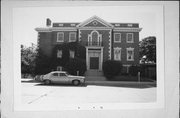| Additional Information: | [A] DENTICULATED CORNICE. PEDIMENT ABOVE ENTRY. PALLADIAN WINDOW BELOW PEDIMENT. Original cost of construction was $95,000. The club was divided into four units whose main function was to help raise money for the building fund. The units were named after some of the dedicated women. The Baumann Unit was named for Mrs. William Baumann and Mrs. Fred Baumann, Sr., the Graham-Cahoon Unit for Mrs. O.P. Graham and Mrs. Louis F. Cahoon and the Johnson-LaVenture Unit for Mrs. Otie W. Johnson and Mrs. William M. LaVenture. The Simmons Unit was named for Mrs. John B. Simmons and the parlor is named for Mrs. Simmons. Mrs. James G. Chandler was chair of the building fund. The building was dedicated in 1930 and the mortgage burned in 1946. In 1896, Mrs. Hopper, wife of the manager of the Hotel Racine, wanted to organize a Woman's Club. The women were enthusiastic about her plan until they realized that the club would be affiliated with the National Sufferage Society. Half of the women didn't want to do this so on 10/7/1896 they organized the Woman's Club of Racine. They were a federated club, belonging to the State and General Federation. The purpose was "to bring together those interested in the intellectual, cultural, and practical improvements of women, to promote agreeable and useful relations among its members and to advance all interests common to humanity." The aims were: 1. To extend to every member opportunities to serve the club and the community according to the abilities and interests and attainment of each. 2. To enrich each member culturally and spiritually by offering programs and problems both challenging and stimulating. 3. To promote social contacts in units and departments and to provide activities for working together for the good of the club. 4. To be alert to the needs of the city. To develop leadership among members. Their motto was "from posibility to reality" and their flower was the pink carnation. Charter members included Martha Wentworth Hopper, Mrs. David Flett, Mrs. James G. Chandler, Mrs. J.G. McMurphy, Mrs. John C. Clement, Mrs. John B. Simmons, Mrs. William Howard Crosby, Mrs. Olis W. Johnson, Mrs. Walter H. Stearns, Mrs. H.M. Wallis, Mrs. A.J. Horlick, and Sara M. Morrison. Their first meeting place was in the basement of the Universalist Church. Later they met in the Sunday School rooms of the First Presbyterian Church. At another time they were offered, free of charge, rooms on the third floor of the American Bank Building where the Elks Club held their meetings. Some months later they went back to the Presbyterian Church. Later on, the club held their meetings in the Winters Building until it burned. They then moved into rooms above Buffhans Store on Main St. and remained there until their current building was finished. The women took their club life seriously. The gavel was tapped at 2:00 and sometimes they were not adjourned until 6:00. The women always wore hats and gloves which they removed when the program started. They were a very dedicated group of women. It was amazing that all the time they were raising money to build a club house, they were also doing so much for the community. In 1898, they paid for a music supervisor (Lilliam Watts) in the public schools. They maintained two reading rooms which were open on Saturday afternoons-providing books and two volunteer librarians. They presented a pair of outdoor lights to the public library. They did a great deal for park improvement. They gave many hours of work to the American Red Cross during WWI. Cultural programs are provided at each meeting. Each woman has the opportunity for membership in any or all of the six departments: American Home and Garden, Art, Community Affairs, Drama, Literature, and Music. A portion of the club's receipts has always been given philanthropically.
[B] The Woman's Club of Racine was chartered in 1896 with 75 members. It met in the parlors of the First Presbyterian Church until 1916, when it established its own clubrooms in the Buffham Building at 403 Main; they were used until this buidling was dedicated in 1930. It was designed by Roger Kirchoff and Thomas L. Rose, who were Milwaukee architects, and it is probably the largest building in Racine built in the Georgian Revival Style. |
|---|

